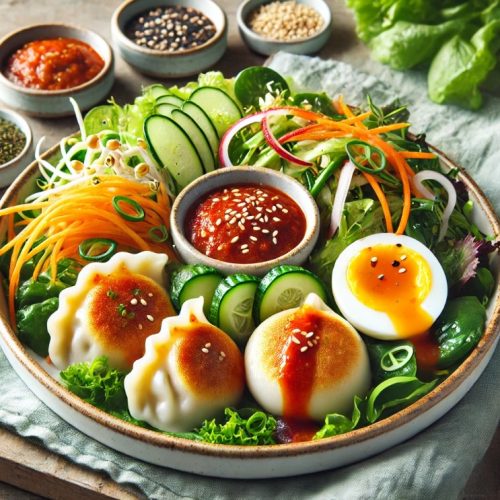
Bibim Mandu Recipe
Bibim Mandu is a vibrant Korean dish that brings together crispy fried or steamed dumplings with fresh, colorful vegetables coated in a sweet, spicy, and tangy gochujang dressing.
Ingredients
- 10-12 frozen or fresh Korean mandu dumplings – pork, chicken, beef, seafood, or vegetarian
- 2 tablespoons vegetable oil for frying or steaming
- For the Salad
- 1/2 head green or red leaf lettuce torn into bite-sized pieces
- 1 small cucumber julienned
- 1/2 medium carrot julienned
- 1/4 red onion thinly sliced
- 1/2 cup bean sprouts blanched (optional)
- 1/4 cup perilla leaves or fresh basil sliced (optional)
- For the Gochujang Dressing
- 2 tablespoons gochujang Korean red chili paste
- 1 tablespoon soy sauce
- 1 tablespoon rice vinegar
- 1 tablespoon sesame oil
- 1/2 tablespoon honey or sugar
- 1 clove garlic minced
- 1/2 tablespoon sesame seeds plus more for garnish
- 1/2 tablespoon water optional, to adjust consistency
- Optional Toppings
- 1 hard-boiled egg sliced in half
- 1/2 teaspoon sesame seeds for garnish
- 1/2 teaspoon sliced green onion or chives for garnish
Instructions
- Heat 2 tablespoons of vegetable oil in a large pan over medium heat.
- Place the frozen or fresh mandu in the pan, ensuring they do not overlap.
- Fry until the bottoms are golden brown, about 3-4 minutes.
- Add 1-2 tablespoons of water to the pan, cover with a lid, and steam for 2-3 minutes.
- Remove the lid and cook for another 1-2 minutes to make the outside crispy.
- Transfer the cooked mandu to a plate lined with a paper towel to remove excess oil.
- Tear the lettuce into bite-sized pieces.
- Julienne the cucumber and carrot.
- Thinly slice the red onion.
- If using perilla leaves or basil, slice them thinly.
- Blanch the bean sprouts if using, and drain well.
- In a large bowl, combine the lettuce, cucumber, carrot, red onion, perilla leaves, and blanched bean sprouts.
- Toss gently to combine.
- In a small bowl, whisk together the gochujang, soy sauce, rice vinegar, sesame oil, honey (or sugar), minced garlic, sesame seeds, and water.
- Adjust the water to reach your desired consistency. The dressing should be slightly thick but pourable.
- Adjust the sweetness, spiciness, and tanginess to your liking by adding more honey, vinegar, or gochujang as needed.
- Pour the gochujang dressing over the prepared vegetables.
- Toss well until all the vegetables are coated with the dressing.
- Arrange the warm, crispy mandu on top of the salad.
- Add hard-boiled egg halves, sesame seeds, and sliced green onions or chives for garnish.
- Serve Bibim Mandu immediately while the mandu are still warm and crispy. This dish works perfectly as a main course, a side dish, or even a light appetizer.